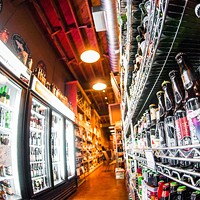It's no secret that beer is taking off in the Queen City. Breweries are popping up all over the place, draft selections are increasing at local bars, and bearded brew dudes are touting their fermented concoctions everywhere from National Public Radio to the Charlotte Observer. What, five years ago, was a city without a single craft brewery, now is a booming beertropolis of six, with several more on the horizon and the bar culture, as it relates to craft beer, continues to improve all the time.
Like so many subcultural groups, the craft beer crowd has a particular vernacular that accompanies its lifestyle. Hackers and other computer enthusiasts understand terms like "finger" and "worm" much differently than your average person. In similar fashion, craft beer culture and the accompanying language might seem quite foreign and even a bit ridiculous to those unfamiliar with it, so I'd like to use this space to decode some basic craft beer terminology, in order to help our kind seem a bit less alien.
Hoppy/Malty
These are sister terms that many will come across at beer-centric bars in town when bartenders are trying to figure out what styles you may enjoy. "Do you like hoppy or malty beers?" That question is going to sound intimidating to someone who has no idea what the hell hops or malts have to do with beer. In the simplest terms, hoppy beers are bitter, like IPAs (India Pale Ales) such as Bells Two Hearted Ale and Birdsong's Higher Ground, or pale ales like Triple C's Light Rail and NoDa Brewing Company's Jam Session. On the other hand, malty beers are sweeter; look for Belgian ales such as Chimay or Rochefort, and barley wines like Brooklyn Monster Ale.
Imperial/Double
These are interchangeable terms used to describe beers with higher alcohol contents and more intense flavors like IPAs, porters and stouts. It may seem counterintuitive, but a lot of people who are just getting into craft beer gravitate toward these higher alcohol brews because they are often sweeter due to the higher alcohol content, and have more intense, easily identifiable flavor profiles. The term "imperial" is used pretty liberally across styles, while "double" or "triple" are generally used to describe IPAs. They imply the use of more ingredients (both hops and malts) and an alcohol content ranging from roughly 7.5 percent to 10 percent, according to the Beer Judge Certification Program.
(Acronyms) IBU, ABV, and SRM
IBU is a commonly touted phrase in craft beer spaces. It stands for International Bittering Units and is a measure of how bitter hops make a beer. It may sound pretty scientific, but oftentimes breweries will actually list a beer's IBUs along with its Alcohol By Volume, or ABV, in the description on menus. IBU doesn't have any relation to how many ounces of hops are in a batch, but how much bitterness the alpha acids in the hops impart to the beer. ABV is a percentage calculation of the amount of alcohol in your beer. Lower ABV beers, called "session" beers, range from 4-5 percent depending on individual interpretation (There is actually a bitter debate raging between Brits and Americans over what actually qualifies as a "session" beer), whereas higher ABV beers can range between 10-15 percent. Some extreme styles even go over 20 percent. Finally, SRM stands for Standard Reference Method and is a measure of how dark and/or clear a beer is. The measurements begin at 2 with pale lagers and witbiers and go all the way to 40+ with imperial stouts.

